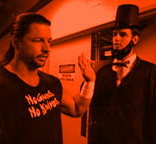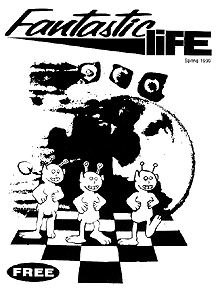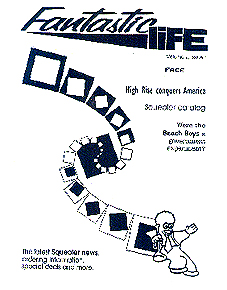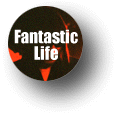Records help make a Fantastic Life!
Shark Quest-Man On Stilts (Merge)
Dudes play in rock band. Dudes discover jazz and international
music. Dudes get bored playing in rock band. Dudes start a "post-rock"
band as they mature beyond the limitations of rock and begin
to incorporate different styles into their work. Defined as
such, "post-rock" aptly describes the music of the Chapel Hill's
Shark Quest. The members are all veterans of the indie-rock
wars of the mid-90s, but after flirtations with various degrees
of pop success, they've retreated into music that's equally
challenging yet less disposable. Man On Stilts (Merge), the
band's second album, doesn't stray far from the designs of their
first, but it's a more confident and complete recording. They
retain their earlier elements: a smattering of Eastern European
hootenanny; a ladleful of Morricone-isms. But this time out
the arrangements pack a stronger punch, the melodies are more
immediate. The intertwining stringed instruments (banjo, cello,
mandolin, guitar) seem to float on melodic airstreams, and casually
shift with an elegance that becomes more pronounced with each
listening.
Thee Headcoats-Elementary Headcoats: The Singles
1990-1999 (Hangman)
But while bands like Shark Quest fill up with members constrained
by the limitations of rock, bands like Thee Headcoats continue
to reinvent the form with surprising dexterity. Seemingly plucked
from a dank British rhythm n' blues club circa 1965 and dropped
kicking and screaming in 1990, Thee Headcoats make primal rock
so impassioned and committed that it puts 99% of everything
thatŐs come before or since to shame. Besides a puritanical
commitment to the sound and aura of classic rnb, Thee Headcoats
are possessed with a wicked sense of humor, the desperate aggression
of a cornered animal, and a propensity towards a high productivity
rate. Despite a catalog containing over 50 lps, singles and
cds, every Thee Headcoats recording has the intensity of a buzzbomb.
As an introduction, Elementary Headcoats: The Singles 1990-1999
(Hangman), is as good a place to start as any, though the record
doesn't compile the band's complete singles, nor is it possible
to discern what the criteria is for inclusion. Still, the band
operates at its best in the short, sharp bursts that singles
provide, and the material here is consistently strong: the collaborations
with Don Craine of 1960's combo Downliners Sect ("Headcoats
On", "Be a Sect Maniac"); the tragicomic tale of afflicted love
that is "Hog's Jaw"; the red letter birthright of "I'm Hurting"
and 47 more over the course of two CDs If you've ever felt those
two rock n' roll chords wearing exceedingly thin, a dose of
this will set your memory straight.
Various Artists-Anthology of Folk Music Volume Four
(Revenant)
Various Artists-Nashville: The Early String Bands
Vol. 1 and 2 (County)
Thee Headcoats stylistic retrenchment reflects a general undercurrent
in contemporary musical culture, as educated music consumers
reject current trends in favor of deeper truths in earlier texts.
Harry Smith's landmark Anthology of American Folk Music, which
compiled obscure recordings from the late 1920's, is one such
primary source. While not exactly household names, the musicians
of Smith's Anthology were once completely forgotten, and they're
now recognized as possessing a primitive essence that's positively
thrilling. The Anthology itself was a surprising economic success,
and that success opened up the gates for more re-releases, the
most widely anticipated of which is Volume Four of the Anthology,
released earlier this year on John Fahey's Revenant label. While
extravagantly packaged and insightfully annotated, Volume Four,
compiled from notes and tapes passed around by Smith himself,
doesn't transcend the material the way the original Anthology
did, due in no small part to the burden of expectations placed
on it by the brilliance of the earlier collection. There's no
way Volume Four could have the same impact, though it's is still
an excellent collection of material from the middle 1930's featuring
some familiar names (Carter Family, the Monroe Brothers, Lead
Belly, Robert Johnson). County Records has been mining this
old-time terrain for years without all the hoopla surrounding
the Anthology, but their output is equally enjoyable. A couple
recent reissues, Nashville: The Early String Bands Vol. 1
and 2, feature a breadth of material from the late 1920's
and the earliest days of the Grand Ol Opry. The label's mainstay
has been Uncle Dave Macon, an all-around entertainer and frailing
banjo picker who appears six times on the two CDs, but the real
surprise is found on Volume Two with the work of harmonica player
Deford Bailey, a black man who was a member of the Grand Ol
Opry from 1926-1941, and who's hybridization of hillbilly music
and the blues is an underappreciated influence.
ABBC-Tete A Tete (Wabana)
John Convertino and Joey Burns are Calexico, a band whose outstanding
dust-bowl atmospheres have graced several Touch and Go albums,
and whose talents are an important part of the band Giant Sand.
They've also collaborated with Victoria Williams and Richard
Buckner, and their new project is a collaboration with the duo
of Naim Amor and Thomas Belhom, two Frenchmen transplanted to
Tucson. This group operates under the name ABBC (for Amor, Belhom,
Burns and Convertino), and their new album is entitled Tete
A Tete (Wabana). It's a serendipitous meeting of minds; Calexico
already possessed a slightly French feel with their extensive
use of the accordion, but Amor and Belhom amplify these tendencies
in a way that allows them to mesh seamlessly with Calexico's
languid desert folk. The opener "Le Valse Des 24 Heures", is
a song as comfortable strolling down the Champs Elysees as it
would be going to the Circle K for smokes; another song is entitled
"En route to the Blanchisserie" which translates loosely as
"Going to the Laundry". Still, despite the relaxed atmosphere,
the music is also incredibly moving: Burns' "Gilbert", which
picks up where Neil Young's post-apocalyptic "On The Beach"
left off, is a slowly building, emotionally gripping drama with
sparse, yet richly detailed, musical accompaniment.
Kayhan Kalhor and Mahammad Reza Shajarian-Night Silence
Desert (Traditional Crossroads)
The desert, both emotional and physical, makes its presence
felt on the new album from Kayhan Kalhor and Mahammad Reza Shajarian.
Kalhor and Shajarian are Iranian musicians, and this album incorporates
the folk music of Khorasan in northeastern Iran with traditional
Persian classical music. Kalhor, as the arranger, brings together
modern and ancient elements of Persian music, and cross-pollinates
different strands with unusual pairings of instruments and styles.
Kalhor is a master of the kamancheh, a bowed instrument similar
to a fiddle in sound, and his trills and sweeping strokes are
mesmerizing. The album's opener, a twenty minute suite subdivided
into five different passages, gradually builds in intensity
until Shajarian joins at roughly eleven minutes in, his richly
emotive voice sending chills down the spine. Shajarian is regarded
as the master of Persian traditional singing, with numerous
international awards to show for it, and his vocal melismatics
echo the swirling of Kalhor's kamancheh. The rest of the album
continues at this exalted level, with "Festive Occasion", on
which the duo are joined by a range of Iranian traditional instrumentalists,
an especially vibrant work.
Abunai!-Round Wound (Camera Obscura)
The collage effect is also used effectively by Boston rock band
Abunai! on their newest release, a compilation of instrumental
recordings from 1997-2000, edited into a nicely paced, seamless
whole. The band's musical hearts are on their sleeves, with
evocative hints of all their heroes; Funkadelic meets Hawkwind
on the opener, "Time of the Funk-Lords", Spacemen 3 on the relentless
"Motorcycle Boots". The band is also meticulous when it comes
to their package design, with the Round-Wound cover art a dead-on
parody of a package of guitar strings.
Anti: Clockwise-Rewatching (Parallelism)
Collage is also the operative key for Tono-Bungay member Robert
Dennis, in his solo guise of Anti: Clockwise. His new recording,
Rewatching (Parallelism), is a trio of lengthy dense electronic
improvisations that have more in common with early 80's British
industrial music (think Throbbing Gristle and Cabaret Voltaire)
than with contemporary electronic strains. Dennis conjures up
a shuddering load of post-media overkill and saturation; the
buzz of late-night television, overheard snatches of music and
conversation, wriggling electric guitar runs and a low-tech
buzzing undercurrent all combine to make a work which strikes
the solar plexus like a dull thud. If this is the sound of the
city, then perhaps a vacation is in order.
Deltron 3030-Self Titled (75 Ark)
Millennial paranoia and dense musical construction are also
key elements to the work of Deltron 3030, the latest project
from wunderkind producer Dan Nakamura (a.k.a. Dan the Automator),
whose work with Kool Keith in Dr. Octagon wrote the book on
whacked-out hip-hop. Here he's joined by Del the Funky Homosapien
on vocals, who spews disjointed, paranoid futurist wordplay
over Nakamura's exquisitely programmed tracks. Nakamura is expert
at crafting eminently hummable songs out of a diverse mixture
of source material, and while Del occasionally gets hung-up
on his own dense locution, the results improve with repeated
listenings until you find yourself singing lines like "underground
chilling with the mole man and his whole fam" until people on
the subway start to look at you strangely.
White Stripes-DeStijl (Sympathy For the Recording
Industry)
There's a surface simplicity to the Detroit duo the White Stripes
that conceals a complex talent. Guitarist/vocalist Jack White
and his drummer sister Meg are often misidentified as a garage
band due to their stripped-down lineup and interest in the blues.
Unlike a sad majority of musicians following the garage path
because they're too lazy or unimaginative to carve out their
own sound, the White Stripes boldly dive into the form with
an eye on creating something new and remarkable from the basic
pieces. As their album proves, the White Stripes are able to
incorporate the blues in the same manner as the late 60's British
bands did, by using the form as a convenient emotional and structural
jumping-off point for more complex explorations. Despite only
being a duo, the band have the kick of early Led Zeppelin and
Mick Taylor-era Rolling Stones; the slide guitar driven "Little
Bird" and Son House's "Death Letter" both roll with a Page/Plant
swagger, while managing to avoid sounding like a cock-rock cliche.
Mr. White even does a creditable Mick Jagger on "Sister, Do
You Know My Name?". But beyond the exceptional skills of being
able to incorporate their classic rock reverence without coming
off as a parody, the duo has the uncanny ability to write memorable
three chord songs like "You're Pretty Good Looking" that lodge
in your brain with an immediacy that makes them thoroughly contemporary.
Faust-The Land Of Ukko and Rauni (Ektro)
The band Faust were one of the chief proponents of German rock
in the 1970's, and while most of their American and British
rock peers have long since devolved into irrelevancy, Faust's
current lineup may be the most daring incarnation of the band.
Original members Werner Zappi Diermaier and Hans Joachim Irmler
are the current mainstays, and their recent work moves even
further into an atmospheric ethno/techno realm that will appeal
to electronic fetishists and graying psychedelic warriors alike.
This album is an excellent document of where their heads are
at these days. In the early 70's the band explored a variety
of different tonalities, many of which were pretty close to
conventional rock, though with a delightfully skewed sensibility.
Today's Faust create lengthy sound beds that they embellish
over the course of almost an hour and a half over the course
of the two CDs of this set, eventually unfolding into a familiar
tribal rhythm on the first disc's closer "As You Might Know
(Du Weoisst Schon)", continuing to add dense textures and claustrophobic
elements until the song throbs with futuristic menace.
I-Roy-Touting I Self (Heartbeat)
Jamaican DJ I-Roy followed in the wake of the similarly-named
U-Roy and Dennis Alcapone in the mid-70's, but his erudition,
harmonically sophisticated flow and lyrical humor soon led him
to become one of the most popular Jamaican DJs. Touting I
Self is a career-spanning collection chosen by I-Roy himself
(otherwise known as Roy Reid) just prior to his death, though
the liner notes are a bit shaky as far as pinpointing the dates
of release or other discographic details. In Heartbeat's defense,
it takes a master detective to sort out the vagaries and evolution
of the DJ stock-in-trade "versions"; remakes of songs utilizing
a familiar rhythm track with new vocals placed on top. Most
of these tracks originate in the mid-70's, certainly a golden
age for reggae, and the musical tracks are thick with reverb
and warmth. I-Roy is adept at a quick lyrical flow, but his
sweet singing voice is his secret weapon, and he sings his lyrics
as often as he toasts them. His melodic singing works to great
effect on the best tracks, including one of a series of jibes
at fellow DJ Prince Jazzbo, "Set Yourself Jazzbo", which also
manages to be one of I-Roy's funniest tracks full of playful
taunts towards his competitor.
Vladislav Delay-Anima (Mille Plateaux)
"Atmospheric" is pretty much the operative word when dealing
with most modern electronic music, but Finnish producer Vladislav
Delay develops more effective atmospheres than most on his new
record Anima (Mille Plateaux). Delay's work bubbles and pops
in a manner similar to others operating in a modern dub style
(such as Pole), but he also incorporates musical elements similar
to composer Angelo Badalamente (of Twin Peaks fame) on the lengthy
tracks, which gives his work a menacing undercurrent and an
extramusical tension.
Yoko Ono-Blueprint For a Sunrise (Capitol)
It's difficult to disconnect the work of Yoko Ono from her biography,
and while most people know only surface details of that biography
(Fluxus artist, John Lennon's wife, grieving widow), she's spent
much of her subsequent career reacting to it. Her new CD, Blueprint
For a Sunrise, a sequel to 1995's Rising, continues her
exploration of women's rights and the self-identity issues that
have characterized her musical work for years. Unfortunately,
most listeners will bring a predisposition (or lack thereof)
to the proceedings before they even hear a note. Her unfettered
voice can be shockingly primal, with trills and guttural rumblings
that are almost animalistic ("Mulberry," in particular, a live
duet between Ono and her son, Sean, will drive the less experimentally
inclined from the room almost immediately), but in other places,
like on "I Remember Everything," Ono crafts rock in the grand
tradition of dramatic performers like Jim Morrison and David
Bowie. Lyrical references to spousal abuse give the voyeuristic
plenty of grist for the mill, but despite the reputation for
difficulty that proceeds Ono's music, Sunrise is attractive
for both Ono's brave songwriting and a number of eminently listenable
songs. As time grows between Ono and the biographical details
that shaped her public persona, a more sympathetic view of her
work begins to emerge. Once a mere footnote to her biography,
Ono's music is now considered on its own merits, and it offers
a number of pleasures, even while it continues to thoughtfully
provoke.
Beachwood Sparks-Once We Were Trees (Sub Pop)
The Los Angeles band Beachwood Sparks traffics in the accoutrements
of country-rock as practiced by the Flying Burrito Brothers
and the Byrds, but they are really the inheritors of an airy
Los Angeles rock sound which has floated out of the canyons
and off the sidewalks like an evocative sunset since the folk-rock
boom of the mid-60's. Brian Wilson's Beach Boys have become
an active influence on independent rock artists, and it is from
the indie milieu that Beachwood Sparks spring (the band includes
members of Further, the Lilys and the Pernice Brothers). Contemporary
indie artists are attempting to recreate Wilson's elaborate
orchestrations on a budget, and a pedal steel guitar comes in
handy when evoking a shimmering emotionalism, while the iconography
of country music equally perfect for evoking the themes of confusion,
longing and loss. Country music's cloak of authenticity is a
template contemporary artists can use to jumpstart their own
expression, and it's in this manner that Beachwood Sparks utilize
it on their second full length album Once We Were Trees.
Beachwood Sparks aren't so much a country-rock band as an orchestral
rock band that uses country colorings for atmosphere. A more
accurate comparison may be that they combine a Strawberry Alarm
Clock innocence with a Procul Harum orchestral melancholy, give
or take a banjo or two. There's an understated elegance to much
of the music, and a sweet softness that's perfect for drifting
fall afternoons. But the band succumbs to some of the worst
indie rock tendencies, including a disconnected lyrical obscurity,
and an inability to self-edit. Some of the songs feel underdeveloped
despite all the pretty textures in which they're wrapped, and
they don't hold up well in comparison to the classics of the
genre. But when analyzed outside of country rock and within
the broader L.A. musical tradition, the record makes more sense.
I keep hoping they'll go for the jugular, to attack the songwriting
and performance with aggressive confidence as opposed to studied
nonchalance, but with repeated listenings the charms of the
record come through.
Aphex Twin-Drukqs (Warp/Sire)
Richard James, the clown prince of electronica, returns with
his first album in 5 years, a double CD set clocking in at over
100 minutes. Radiohead spent a good bit of his absence singing
his praises, but even without the reflected glow his work is
as exciting and innovative as ever, running the gamut from jittery
electofunk to meditative pieces that are almost classically
romantic. There's a breadth to his work that few other electronic
artists are able to pull off. The extremes of his harsh electronics
can be uncompromisingly discordant, but the flip is the kinetic
rush of tracks like "Omgyjya-Switch", which are totally exhilarating.
Even more impressive is the range of material on the quiet side,
from haunting atmospheres to Satie-influenced piano solos.
The North Mississippi Allstars-51 Phantom (Tone-Cool)
The North Mississippi Allstars, whose new record 51 Phantom
is out on the Wellesley Hills, MA label Tone-Cool, are poster
boys for the problematic issues facing contemporary southern
rock. Drummer/vocalist Cody and guitarist/vocalist Luther Dickinson
are the talented duo at the core of the NMAS, both the sons
of legendary producer/musician Jim Dickinson, a man whose lengthy
resume includes almost forty years of work with the likes of
Big Star, Ry Cooder, the Rolling Stones, Primal Scream, the
Replacements and a host of others misfits and oddballs, both
known and obscure. Dickinson Sr.'s iconoclastic instincts are
one of the saving graces for the NMAS, as the two brothers begin
their musical journey at a more enlightened point than most
to the possibilities presented by southern music, and this openness
saves them from bar-band purgatory. NMAS remain true to their
roots in the country blues while incorporating a slew of contemporary
influences, including radio rock, heavy metal and modern production
techniques, yet they're still burdened by the influence of the
first generation of southern rock bands such as ZZ Top, and
especially, the Allman Brothers, who definitively wed blues
to rock in such a majestic manner that further musical progression
in the region has been retarded for more than twenty years.
While the trio of opening tracks represents their take on the
boogie styles best exemplified by ZZ Top, the band eventually
settles in to a gentle rusticity that evokes the fife and drum
sounds of Othar Turner (a production client of Luther Dickinson's)
and the simple, wide open elegance of the Allman's "Blue Sky"
(quoted directly during the guitar solo of "Lord Have Mercy").
While the music isn't always distinctively original, the band's
honest approach and obvious intelligence help them retain a
freshness that many of their contemporaries lack. "Mud", the
closing track, is a musical anomaly (the Metallica/beatbox hybrid
of its sonics is the closest the band gets towards contemporary
rock radio fodder), but is also the band's most complex statement
of purpose: the mud both a metaphoric source of pride ("I'm
in the mud and the mud's in me"), as well as mysterious source
of their strength ("if you don't know, I ain't gonna tell you").
It's a fitting close to a record that hints at the strengths
of a band just beginning to get their feet wet.










